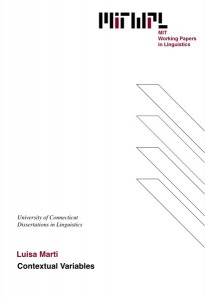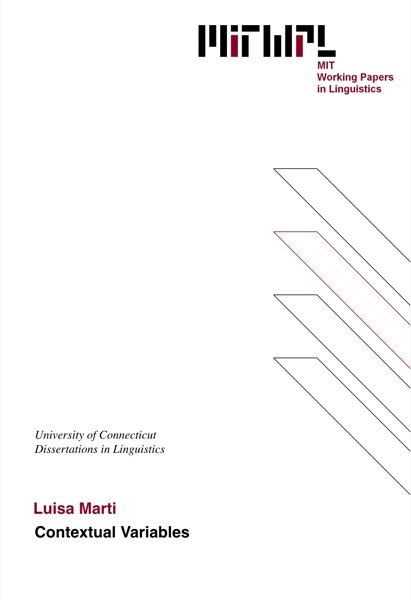Contextual Variables
L. Marti, 2003
Abstract (Summary)
The hypothesis pursued in this dissertation is that contextual variables (C) of the kind assumed for quantifiers like every or only are pronouns. One major advantage of taking this position is that if the behavior of contextual variables is regulated by principles that are needed independently for pronouns, language acquisition is made easier on the child. This is specially important because the behavior of C varies cross-linguistically.
The C of quantificational expressions like every or no can be bound and is subject to the kinds of constraints that bound pronouns are subject to. In particular, C is subject to WCO in English, Chinese and Spanish. In addition, whenever we find exceptions to WCO with pronouns in English, we find the same exceptions with C. The distribution of Chinese bound pronouns is more constrained than in English, and the distribution of C in Chinese is also more constrained.
As for free instances of C, I argue against analyses of association with focus that postulate non-pronoun-like constraints on C, since such analyses force a departure from the hypothesis that C is a pronoun. In the alternative analysis of association with focus proposed here, the burden of explanation is shifted to constraints on (implicit) discourse structure (Roberts (1996/1998), to which I add a principle based on maximal informativity. These constraints narrow down the kinds of contexts where sentences are felicitous. It is because of properties of the contexts in which sentences with only are felicitous that association-with-focus readings obtain: they contain only one suitable antecedent for the contextual variable of only . The same analysis is pursued for even, also and always , where certain difference between always and only (Beaver and Clark (2001, 2002a, b), Cohen (1999)) are explained. Maximal informativity finds additional support from facts independent of association. Other analyses of association, such as Rooth's (1992), are critically reviewed.
Table of Contents
Chapter 1: Contextual Variables: Introduction
1.1 Goals of the dissertation....................................................................................................1
1.2 Bound and free variables...................................................................................................4
1.2.1 Bound and free pronouns.....................................................................................4
1.2.2 Bound and free contextual variables....................................................................7
1.3 Association with focus.......................................................................................................12
1.4 Association with focus across languages..........................................................................20
Appendix How to calculate focus semantic values...............................................................30
Chapter 2: Bound Contextual Variable
2.1 Introduction......................................................................................................................36
2.2 Constraints on C..............................................................................................................47
2.2.1 A constraint on bound C in English, Chinese and Spanish..............................................49
2.2.2 Cross-linguistic variation with possessive binders of C....................................................64
2.3 Other contextual variables................................................................................................71
2.4 Conclusion to chapter 2....................................................................................................85
Chapter 3: Free Contextual Variables I
3.1 A focus constraint on C......................................................................................................88
3.2 Rooth (1992) and von Fintel (1995, 1995).........................................................................94
3.2.1 An empirical problem..........................................................................................................94
3.2.2 Can the FIP be saved?......................................................................................................100
3.2.3 Conceptual issues..............................................................................................................108
3.2.4 Summary of section 3.2......................................................................................................108
3.3 Maximal informativity..........................................................................................................109
3.4 Reconstruction and information structure...........................................................................117
3.4.1 Roberts (1996/1998)...........................................................................................................117
3.4.2 Maximal informativity and context reconstruction...............................................................124
3.4.3 Context reconstruction in denials and with because and only...........................................137
3.4.4 von Fintels point revisited..................................................................................................141
3.4.5 Remaining issues...............................................................................................................151
3.4.6 Summary of Section 3.4.....................................................................................................157
3.5 Presuppositional effects of focus........................................................................................158
3.6 Review of other analyses....................................................................................................164
3.6.1 Schwarzchild (1997)............................................................................................................164
3.6.2 Roberts (1996/1998)............................................................................................................169
3.7 Conclusion to chapter 3.......................................................................................................171
Appendix Strong and weak answers......................................................................................174
Chapter 4: Free Contextual Variables II
4.1 Introduction...........................................................................................................................178
4.2 The readings of sentences with adverbs of quantification....................................................187
4.2.1 A semantics for adverbs of quantification.............................................................................187
4.2.2 Focus-unrelated readings.....................................................................................................190
4.2.3 Focus readings.....................................................................................................................198
4.3 Why are only and always different?....................................................................................211
4.4 Review of other analyses......................................................................................................213
4.4.1 Beaver and Clark (2001, 2002).............................................................................................213
4.4.2 Rooth (1992)/von Fintel (1994, 1995)...................................................................................219
4.4.3 Geurts and van der Sandt (1997,1999)................................................................................219
4.4.4 Roberts (1996/1998) and Schwarzchild (1997)....................................................................224
4.4.5 Herburger (2000)..................................................................................................................225
4.5 Conclusion to chapter 4
Appendix The official semantics for adverbs of quantification
Chapter 5: Conclusion
5.1 Summary of the dissertation.................................................................................................233
5.2 Prospects for future research...............................................................................................237

